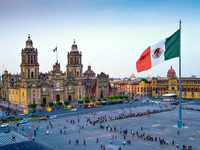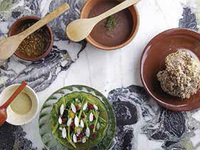Mexico is no longer a developing country; in fact, it’s the 15th largest economy in the world thanks in part to its three strongest sectors: energy, agriculture and tourism.
 Mexico might have problems with high crime and bribery, but it’s managed to reach such a lofty economic position as every successive government has adhered to standard international economic rules and a legal framework. Each president has a six-year term – with no chance of reelection. In recent years, the presidency has changed hands among various parties; at the start of 2019, the left-wing Andrés Manuel López Obrador – known almost universally as AMLO – took power with 53% of the vote with a promise to end corruption and serve the poor. More importantly, since coming to power, he’s managed to grab an approval rating of 80%. And because Mexico’s constitution and independent legal system are sound, foreign investors are active in the country – in fact, they’re becoming more active in the country – in spite of the leftist government. Ultimately, with its supply of cheap and plentiful labor, Mexico continues to attract global companies.
Mexico might have problems with high crime and bribery, but it’s managed to reach such a lofty economic position as every successive government has adhered to standard international economic rules and a legal framework. Each president has a six-year term – with no chance of reelection. In recent years, the presidency has changed hands among various parties; at the start of 2019, the left-wing Andrés Manuel López Obrador – known almost universally as AMLO – took power with 53% of the vote with a promise to end corruption and serve the poor. More importantly, since coming to power, he’s managed to grab an approval rating of 80%. And because Mexico’s constitution and independent legal system are sound, foreign investors are active in the country – in fact, they’re becoming more active in the country – in spite of the leftist government. Ultimately, with its supply of cheap and plentiful labor, Mexico continues to attract global companies.
The capital, Mexico City, is located in a flat area in the center of the country. One of the world’s largest cities with 21 million people, Mexico City was built on top of a drained lake after the Spanish conquest. Since then, the city has expanded thanks to the lack of hills; this sprawl also means that it does not have many tall buildings. What’s more, the crime rate isn’t as high as the frightening levels of yesteryear, as the city center is now much safer. Mexican street food is out of this world; in terms of cleanliness, the street grills might pose a bit of a risk, but there are always little restaurants in every neighborhood offering street food to 15 to 20 customers at a time. If you’re in Mexico, you just have to try them, especially for lunch. Soft corn tortillas, for instance, are scrumptious when you combine them with refried beans, guacamole, sautéed mushrooms, sour cream and grated cheese.
If you want a bit more, you can add meat or shrimp as well. And on the table, you’ll always be able to find a sauce that suits your tolerance for spice. Put it all together, and it’s a delicious bite for next to nothing. A warning, though: it is addictive, and the Mexican restaurants outside the country just can’t offer the same flavor. In such a spread-out city, there are hundreds of such restaurants throughout the capital – just ask at your hotel for one to go to nearby.
PUJOL
 There are two particularly important restaurants in Mexico City – but my favorite is Pujol, the preserve of Enrique Olvera, a Mexican who seems to have gone straight from the cradle to the chef’s table. Michelin isn’t in Mexico, but if it were, Pujol would be a lock to get two stars. Pujol’s foundation rests on street food, but what Olvera has done was refine Mexico’s rather greasy and delectable street food in the kitchen. Pujol provides two delicious tasting menus, one vegetarian and one pescatarian, with top-notch service. And that’s not all; the wine list is very broad, and the sommeliers really know their stuff. If you go as two people, go for both tasting menus – that way, you can share the best of both worlds. Otherwise, go twice if you have the time because it’s really worth it. But while the prices are reasonable, it’s a tall task to land a reservation, as you usually need to book two months in advance. Pujol offers two sittings; whichever of them you go to, head a bit early so that you can enjoy the bar in the garden. In the end, we sat down at a table, but you might enjoy sitting at the bar. Ultimately, you can sample a similar fare at New York’s Cosme (another Olvera creation), but Pujol is certainly a place I’m itching to go back to.
There are two particularly important restaurants in Mexico City – but my favorite is Pujol, the preserve of Enrique Olvera, a Mexican who seems to have gone straight from the cradle to the chef’s table. Michelin isn’t in Mexico, but if it were, Pujol would be a lock to get two stars. Pujol’s foundation rests on street food, but what Olvera has done was refine Mexico’s rather greasy and delectable street food in the kitchen. Pujol provides two delicious tasting menus, one vegetarian and one pescatarian, with top-notch service. And that’s not all; the wine list is very broad, and the sommeliers really know their stuff. If you go as two people, go for both tasting menus – that way, you can share the best of both worlds. Otherwise, go twice if you have the time because it’s really worth it. But while the prices are reasonable, it’s a tall task to land a reservation, as you usually need to book two months in advance. Pujol offers two sittings; whichever of them you go to, head a bit early so that you can enjoy the bar in the garden. In the end, we sat down at a table, but you might enjoy sitting at the bar. Ultimately, you can sample a similar fare at New York’s Cosme (another Olvera creation), but Pujol is certainly a place I’m itching to go back to.
QUINTONIL
 Like Pujol, Quintonil is another important Mexican institution that requires reservations two months in advance. While Quintonil didn’t leave as big an impression on me as Pujol, it would be a shame not to visit it after going all the way to Mexico City. That’s to say that I might not get to Quintonil again, but I’m glad I visited at least once. The restaurant’s wine list is somewhat narrower, while it doesn’t have the same ambiance as Pujol. Moreover, Quintonil’s accent is more on international food rather than Mexican. In terms of dining, you have to go for a tasting menu at one of Quintonil’s two sittings. Nevertheless, if you don’t eat either meat or fish, they can accommodate you.
Like Pujol, Quintonil is another important Mexican institution that requires reservations two months in advance. While Quintonil didn’t leave as big an impression on me as Pujol, it would be a shame not to visit it after going all the way to Mexico City. That’s to say that I might not get to Quintonil again, but I’m glad I visited at least once. The restaurant’s wine list is somewhat narrower, while it doesn’t have the same ambiance as Pujol. Moreover, Quintonil’s accent is more on international food rather than Mexican. In terms of dining, you have to go for a tasting menu at one of Quintonil’s two sittings. Nevertheless, if you don’t eat either meat or fish, they can accommodate you.
TETETLÁN AND LALO
 If you want to steer clear of the standard hotel breakfast fare, let me recommend a couple of places for a meal to get the day started. Head to whichever one is closer – or head to them both! Both Tetetlán and Lalo combine Mexican cuisine and the food of a modern breakfast café. But the word is out about such places, so if you don’t head early in the day, you’re liable to wait in line. And there’s another plus to going early: You can eat your fill and then wait until dinner before getting hungry again, as it’s impossible to have any lunch after eating a breakfast this big.
If you want to steer clear of the standard hotel breakfast fare, let me recommend a couple of places for a meal to get the day started. Head to whichever one is closer – or head to them both! Both Tetetlán and Lalo combine Mexican cuisine and the food of a modern breakfast café. But the word is out about such places, so if you don’t head early in the day, you’re liable to wait in line. And there’s another plus to going early: You can eat your fill and then wait until dinner before getting hungry again, as it’s impossible to have any lunch after eating a breakfast this big.
ROSETTA AND LA UNICA
If you’re staying in Mexico City for a while and want to try something a bit more upmarket, allow me to recommend a couple of Italian places, Rosetta and La Única – both of which are luxurious Italian establishments. Know, though, that it’s tough to find a good English speaker at the best of times in Mexico; it’s even harder to find in one of these places, meaning you’ll have to make do with Italian or Spanish. That said, you came here for the food, not the conversation with the waiters, and the food at both Rosetta and La Única is fantastic. There’s just one underlying question: Should you go to Mexico and have Italian? Only you can answer that – but perhaps you already do that when you head to the U.S. or Britain.
LICORERÍA LIMANTOUR AND MAISON ARTEMISIA
Go to any bar in Mexico City, and you’ll find a thick menu of tequila and cocktails made from the national drink, but there are two places that require a visit for pre-dinner drinks, Licorería Limantour and Maison Artemisia. Sitting out on the sidewalk with a drink and watching the world pass by is a most enjoyable pursuit at either. Artemisia’s interior is also quite nice, and later on in the evening, it has live jazz.
OUT AND ABOUT TOWN
Of course, Mexico City isn’t just about food, and there’s one museum that should command at least half your day: The National Museum of Anthropology. The building’s architecture itself turns your head, but of course, you’ve actually come here for the Olmec, Maya, Aztec and Spanish archaeological riches inside. Together, the various sections take you back as far as 2000 B.C. Grab yourself a good, English-speaking guide and learn about Mexico’s 4,000 years of history – you’ll be glad you did. There are three other museums that deserve your attention: the Soumaya (which devoted a whole floor to Rodine in 2019), Frida Kahlo and Diego Rivera museums. For the three of them, it’s good to allocate at least half a day maybe even one full one (including the travel time).
CANCÚN AND TULUM
If you’ve come all the way to Mexico City, you need to at least treat yourself to a bit of fun in the sea and sand. For that, look no further than Cancún and Tulum. The former is an easy, two-hour flight from the capital with Mexican Airlines. In general, the sea if phenomenal, provided the waves don’t bring in two much seaweed. And on the coast, there are plenty of big, quality international chain hotels; hotel restaurants in the area are good, although there’s no standout restaurant in town. That said, after 6 in the evening, the main square fills with hundreds of food carts serving up terrific street food. Here, there are two local things to try, Marquesitas (a wrap made from crispy corn right in front of your eyes that is filled with Nutella and grated cheese) and Esquites (boiled corn on the cob garnished with mayonnaise and cheese). Of course, you can also find fajitas, burritos, tacos and quesadillas in Cancún, but marquesitas and esquites are both Yucatán specialties. If you happen to be there on a Sunday, you’ll find all of Cancún’s residents alongside you in the square, especially as there are public concerts that last for hours on the day. Located 90 minutes by car from Cancún, the seaside town of Tulum is full of history everywhere you turn. But because it’s inundated by seaweed 10 months of the year, its beach isn’t much of a draw. From the end of November to the end of January, however, the seaweed disappears (which, you won’t be surprised to learn, is when all its touristic pictures are taken). Still, you should spend a couple of days visiting its historical ruins. There are two main historical areas; one is a coastal stone city from Maya times that takes about an hour to tour (but in including the time it takes to get there and away, you’ll have to allow for a half day). From your hotel, hop in a taxi (there is no Uber) and tour the ruins yourself because if you opt for a non-private tour from your hotel, you’ll spend a good part of your day in a bus as the driver picks people up and drops them off. After all, the open-air museum is well-organized, and there are plenty of English signboards around to explain the city. There’s also a Mayan pyramid city that’s further from the beach: Coba. Before you set out, make sure you’ve got sturdy footwear that will allow you to climb the stairs comfortably. And like the ancient ruins of Tulum, a trip to Coba takes half a day. For both, make sure you get there by about 9 in the morning, lest you find yourself swamped among the crowds from the tourist buses – and fatigued due to the searing heat. And if you happen to be there during a seaweed-free time, cap your day off with a dip in the water.
